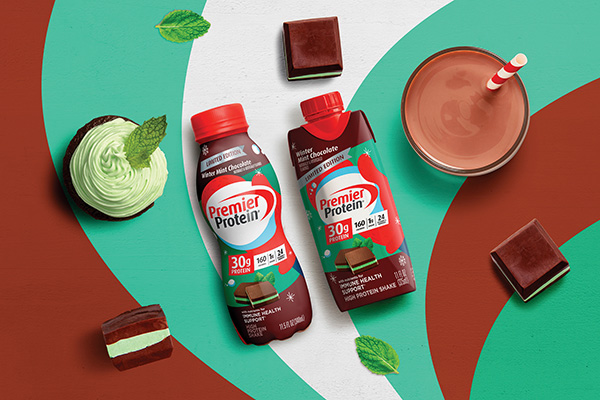Family
Holiday Must-Haves: Make holiday shopping a cinch
There’s nothing quite like the joy of watching a loved one’s face light up when opening a gift you selected with care, but holiday shopping can be a chore.
Last Updated on November 26, 2025 by Daily News Staff
(Family Features) There’s nothing quite like the joy of watching a loved one’s face light up when opening a gift you selected with care, but holiday shopping can be a chore.
If you’re a shopper at heart, it may be a challenge you enjoy, but if the idea of holiday shopping brings out the Grinch in you, consider these ideas for gifts to delight those you love this holiday season.
Look for more ideas to make this holiday season magical at eLivingtoday.com.
Power Up Your Holidays with Protein
Whether you’re out shopping or traveling for the holiday, savor the season without compromising health goals by treating yourself to a Premier Protein Winter Mint Chocolate High Protein Shake. Featuring cozy chocolate and refreshing mint flavors, this seasonal favorite is back, but for a limited time only. Flavorful and packed with the nutrition you need, each shake includes 30 grams of protein, 160 calories and 1 gram of sugar. Whether you drink this shake on its own or use it as an ingredient, you can ring in the season with a healthy amount of vitamins C and E, important antioxidants to support a healthy immune system as part of a healthy diet and lifestyle. Learn more at PremierProtein.com.
Holiday Sweets for a Good Cause
Few things go together like the holiday season and sweet treats. By gifting family and friends Wendy’s Frosty Key Tags, which are good for a free Jr. Frosty with every purchase, you can give back all year long because proceeds from every tag sold helps the Dave Thomas Foundation for Adoption find loving, adoptive homes for children in foster care. Available for purchase every November and December, tags are good for one full year and can be purchased in-restaurant, at the drive-thru, via a kiosk, through the app or at Wendys.com.
Step Up Gifting with Fashion-Forward Footwear
Every fashionista knows there’s no such thing as too many shoes, and that includes ankle boots and booties that never go out of style. These low-slung styles can be dressed up or down, depending on the look you’re wearing. Among this season’s hottest designs are faux animal prints, such as cheetah or snakeskin, that add some playful color and texture to complete an ensemble. If you’re not sure about the color or style, a classic black or brown bootie with well-padded soles and a moderate heel is a versatile choice with universal appeal.
Brrr-ing Gifts of Warmth and Good Cheer
Give loved ones an easy way to brighten a cold, dreary day with a cute and cozy matching hat and glove set. It’s a thoughtful and practical gift that brings a smile to recipients’ faces each time they don those warm layers to face a blustery day. What’s more, with all the options for personalization, it’s an affordable way to show you care. When choosing the perfect duo, keep your loved ones’ tastes and preferences in mind. You can find hats and gloves to match virtually any interest, whether it’s a favorite color, sports team or pop culture reference.
Holiday Shopping Hot List
Turns out, Santa may be onto something. Making your list and checking it twice can help you save money (and your sanity) during the holiday season.
- Set a budget and stick to it. Remember to include all your seasonal expenses, including Secret Santa and teacher gifts, ingredients for dishes you’ll take to potluck gatherings and admission to special holiday activities.
- Make a list. Having an idea of what you’d like to buy can help you stick to your budget and avoid frustration when you’re in the stores. You’ll be more likely to avoid costly impulse purchases and you’ll be more efficient while shopping. If you can, jot down a couple of backup ideas just in case what you want proves hard to find or exceeds your budget.
- Shop for deals. Before you head out shopping, research specials on the items on your list. You may be able to adjust your timing to take advantage of sales or find steep discounts at stores you don’t normally visit.
- Give yourself plenty of time. If holiday shopping stresses you out, it’s a good idea to start early. That way you can tackle a little at a time and avoid feeling the pressure of a ticking clock. Also try shopping during off-peak hours, such as during the week, when stores are likely to be less crowded.
- Map out your plan of attack. Planning the most direct route to travel from one retailer to the next can help keep you organized and avoid unnecessary backtracking. You can also save time and gas by making purchases online. Be sure to watch for promotions that provide free shipping and be conscious of shipping times to ensure gifts arrive in time for the big day.
Photo courtesy of Getty Images (couple with gifts)
Photos courtesy of Unsplash (boots and hats)
SOURCE:
Premier Protein
Wendy’s
Discover more from Daily News
Subscribe to get the latest posts sent to your email.
Stories of Change
The Holiday Spirit Matters But So Does What Happens After
The Holiday Spirit: Holiday generosity is powerful, but community needs don’t end when the decorations come down. Learn practical ways to give back year round—volunteering, donating, sharing skills, and supporting causes you believe in—with help from United Way.

The Holiday Spirit Matters — Why Giving Back Should Last All Year
(Family Features) During the holiday season, many people feel a renewed sense of generosity. It’s a time when communities come alive with food drives, toy collections, volunteer events and donation campaigns – all fueled by the spirit of giving. While this seasonal energy can be powerful, the need it responds to doesn’t fade when the decorations come down. Giving back is not only essential during the holidays; it’s also the foundation of stronger, more resilient communities year round. People in nearly every community face challenges – whether it’s affording holiday presents or meeting basic needs like food, rent and utilities. For many families, current economic strains are forcing them to make tough decisions like sacrificing necessities or depleting savings to create moments of holiday joy. This is a time to rally support and help neighbors in need. Right now, many community members who didn’t previously need help are seeking support. Acts of generosity large and small help close gaps and strengthen communities. When individuals and businesses give their time, resources and talent, they can help ensure everyone has a fair chance to not only survive but thrive. Communities rely on nonprofit organizations like United Way – one of the oldest and largest organizations committed to tackling local challenges and mobilizing communities to improve lives. With a presence in nearly 99% of communities across the U.S., the organization recognizes the power of giving and relies on seasonal and year-round generosity to deliver food and housing assistance, youth programs, mental health support, disaster recovery and more. This holiday season and beyond, to assist your community consider taking actions such as: Volunteering Offering your time is one way to make a real change in your community while helping build a more resilient future for all. What’s more, research shows the personal benefits of volunteering, such as reduced feelings of isolation, loneliness and risk of depression. Whether it’s a community event, ongoing support or in-person activities, making a difference for others feels good. Donating Sharing your financial resources can play a vital role in helping communities thrive. Your donation can help put food on the table for families in need, support kids who are struggling or provide mental health services to the most vulnerable individuals. Remember, your gift of any size combines with the gifts of others and builds stronger, more resilient communities. Sharing Expertise or Talent Generosity can take many forms. Making a difference isn’t just about time and money; it can also mean sharing skills or knowledge, and even social networks to bolster charitable efforts. Giving back builds a shared sense of responsibility. It reminds people that strong communities don’t happen by accident – they’re created through connection, compassion and collective action. Supporting Causes You Believe In Every community faces their own unique, pressing challenges and almost everyone has a cause that’s close to their hearts. Identify organizations working to advance those causes and make a plan to support them. Find opportunities to support your community this holiday season and make generosity a year-round tradition at unitedway.org/local.
This is a time to rally support and help neighbors in need. Right now, many community members who didn’t previously need help are seeking support. Acts of generosity large and small help close gaps and strengthen communities. When individuals and businesses give their time, resources and talent, they can help ensure everyone has a fair chance to not only survive but thrive. Communities rely on nonprofit organizations like United Way – one of the oldest and largest organizations committed to tackling local challenges and mobilizing communities to improve lives. With a presence in nearly 99% of communities across the U.S., the organization recognizes the power of giving and relies on seasonal and year-round generosity to deliver food and housing assistance, youth programs, mental health support, disaster recovery and more. This holiday season and beyond, to assist your community consider taking actions such as: Volunteering Offering your time is one way to make a real change in your community while helping build a more resilient future for all. What’s more, research shows the personal benefits of volunteering, such as reduced feelings of isolation, loneliness and risk of depression. Whether it’s a community event, ongoing support or in-person activities, making a difference for others feels good. Donating Sharing your financial resources can play a vital role in helping communities thrive. Your donation can help put food on the table for families in need, support kids who are struggling or provide mental health services to the most vulnerable individuals. Remember, your gift of any size combines with the gifts of others and builds stronger, more resilient communities. Sharing Expertise or Talent Generosity can take many forms. Making a difference isn’t just about time and money; it can also mean sharing skills or knowledge, and even social networks to bolster charitable efforts. Giving back builds a shared sense of responsibility. It reminds people that strong communities don’t happen by accident – they’re created through connection, compassion and collective action. Supporting Causes You Believe In Every community faces their own unique, pressing challenges and almost everyone has a cause that’s close to their hearts. Identify organizations working to advance those causes and make a plan to support them. Find opportunities to support your community this holiday season and make generosity a year-round tradition at unitedway.org/local. Nourishing Our Heroes: Eight Years of Impact at Phoenix VA’s Veggies for VeteransLink: https://stmdailynews.com/nourishing-our-heroes-eight-years-of-impact-at-phoenix-vas-veggies-for-veterans/
Stories of Change: People Making a Difference
Discover inspiring stories of changemakers making a positive impact. Explore videos and articles of people tackling today’s biggest challenges with action and hope. Visit: https://stmdailynews.com/stories-of-change/
STM Daily News is a multifaceted podcast that explores a wide range of topics, from life and consumer issues to the latest in food and beverage trends. Our discussions dive into the realms of science, covering everything from space and Earth to nature, artificial intelligence, and astronomy. We also celebrate the amateur sports scene, highlighting local athletes and events, including our special segment on senior Pickleball, where we report on the latest happenings in this exciting community. With our diverse content, STM Daily News aims to inform, entertain, and engage listeners, providing a comprehensive look at the issues that matter most in our daily lives. https://stories-this-moment.castos.com/
Discover more from Daily News
Subscribe to get the latest posts sent to your email.
Last Updated on December 18, 2025 by Daily News Staff

Keeping Pets Safe This Holiday Season: 5 Festive Safety Tips for Pet Owners
(Family Features) The holiday season brings sparkling lights, cherished traditions and joyful gatherings with the people and pets you love most. As you deck the halls and prepare for cozy celebrations, it’s important to remember some of the magic of the season can also pose risks for curious cats and dogs. To provide pet owners added peace of mind, consider these tips from the experts at VCA Animal Hospitals, a leader in veterinary care with more than 1,000 locations dedicated to positively impacting pets, people and the communities they serve, to keep the holidays merry – and safe – for everyone. Decorations and Festive Outfits From family photos to holiday cards, many pet owners love including their companions in the festivities. If you dress your pet for pictures, choose outfits that are comfortable, allow easy movement and don’t interfere with breathing or vision. Pets are naturally drawn to shiny and dangling decor, so opt for shatterproof ornaments and avoid using tinsel, which can cause serious internal issues if swallowed. Hang small or salt-dough ornaments high on the tree, out of paws’ reach, to help prevent choking. After opening gifts, promptly discard wrapping paper, string and ribbon; items that may seem fun to play with but can be dangerous if ingested. Food and Drinks Holiday tables overflow with delicious treats, but many seasonal foods can be harmful to pets. Chocolate, grapes, raisins, xylitol-sweetened candies and leftover meat scraps may lead to serious illness. Politely remind guests not to slip your pet any treats, no matter how festive the occasion feels. Quickly pack away food when meals end to help reduce temptation. Alcoholic beverages should also be kept well out of reach. Pets absorb alcohol much faster than humans, and even small amounts can cause alcohol poisoning. Candles and Burns The glow of candles and warm fireplaces add comfort and charm this time of year, but open flames pose fire risks and burn hazards for pets. Keep pets at a safe distance from fireplaces, wood stoves and space heaters, as curiosity can bring them too close. Consider using battery-operated candles in place of traditional ones. If you use real candles, ensure they’re placed out of reach and never left unattended; even stepping away for a moment can increase the risk of accidents. Plants and Trees Holiday greenery brings beauty to your home, but some plants require extra caution around pets. While Christmas trees themselves are generally non-toxic, the water in the tree stand may contain mold, bacteria or fertilizers. Use a tree skirt or cover to prevent pets from drinking from it. Decorative plants like poinsettias, mistletoe, lilies, holly and amaryllis can cause gastrointestinal upset if nibbled on. Keep these seasonal favorites well out of reach, especially if you live with adventurous or plant-curious pets. Cold Weather Walking Winter walks can be refreshing for you and your dog, but shorter days and colder weather mean extra care is needed. Use a non-retractable leash during early morning or evening walks, and ensure both you and your pet wear high-visibility gear so drivers and others can easily spot you.
If you live in an area with snow or ice, monitor conditions closely and watch the wind chill. Dressing your dog in a warm sweater or jacket and offering booties for paw protection can help them stay comfortable and safe on frosty outings. By taking a few thoughtful precautions, you can help ensure your pets enjoy a safe, joyful holiday season right alongside the rest of the family. If you have questions about winter safety or your pet’s health, consult your veterinarian. For more tips to keep your pet safe this holiday season, and to find a location near you, visit vcaholiday.com. Photos courtesy of Shutterstock
Food and Drinks Holiday tables overflow with delicious treats, but many seasonal foods can be harmful to pets. Chocolate, grapes, raisins, xylitol-sweetened candies and leftover meat scraps may lead to serious illness. Politely remind guests not to slip your pet any treats, no matter how festive the occasion feels. Quickly pack away food when meals end to help reduce temptation. Alcoholic beverages should also be kept well out of reach. Pets absorb alcohol much faster than humans, and even small amounts can cause alcohol poisoning. Candles and Burns The glow of candles and warm fireplaces add comfort and charm this time of year, but open flames pose fire risks and burn hazards for pets. Keep pets at a safe distance from fireplaces, wood stoves and space heaters, as curiosity can bring them too close. Consider using battery-operated candles in place of traditional ones. If you use real candles, ensure they’re placed out of reach and never left unattended; even stepping away for a moment can increase the risk of accidents. Plants and Trees Holiday greenery brings beauty to your home, but some plants require extra caution around pets. While Christmas trees themselves are generally non-toxic, the water in the tree stand may contain mold, bacteria or fertilizers. Use a tree skirt or cover to prevent pets from drinking from it. Decorative plants like poinsettias, mistletoe, lilies, holly and amaryllis can cause gastrointestinal upset if nibbled on. Keep these seasonal favorites well out of reach, especially if you live with adventurous or plant-curious pets. Cold Weather Walking Winter walks can be refreshing for you and your dog, but shorter days and colder weather mean extra care is needed. Use a non-retractable leash during early morning or evening walks, and ensure both you and your pet wear high-visibility gear so drivers and others can easily spot you.
If you live in an area with snow or ice, monitor conditions closely and watch the wind chill. Dressing your dog in a warm sweater or jacket and offering booties for paw protection can help them stay comfortable and safe on frosty outings. By taking a few thoughtful precautions, you can help ensure your pets enjoy a safe, joyful holiday season right alongside the rest of the family. If you have questions about winter safety or your pet’s health, consult your veterinarian. For more tips to keep your pet safe this holiday season, and to find a location near you, visit vcaholiday.com. Photos courtesy of Shutterstock Keeping Pets Safe This Holiday Season: 5 Festive Safety Tips for Pet Owners
SOURCE: VCA Animal HospitalsThe fate of Lucky Supermarkets in SoCalLink: https://stmdailynews.com/the-fate-of-lucky-supermarkets-in-socal/
Discover more from Daily News
Subscribe to get the latest posts sent to your email.
Family
5 Tips to Pull Off Holiday Hosting
With stay-at-home holidays a thing of the past for many families, they’re now busy preparing for full-blown celebrations. The return of traditional festivities brings seemingly never-ending to-do lists and pressure to be the perfect host.
Last Updated on December 17, 2025 by Daily News Staff
(Family Features) With stay-at-home holidays a thing of the past for many families, they’re now busy preparing for full-blown celebrations. The return of traditional festivities brings seemingly never-ending to-do lists and pressure to be the perfect host.
From mastering a mouthwatering menu and donning your home with decadent decor to ensuring guests enjoy the evening to the fullest, hosting duties bring plenty of responsibilities. This year, though, you can avoid those anxious feelings with some preparation ahead of the big day.
To help pull off a sensational seasonal soiree, consider these tips from the entertaining experts at Sun-Maid to make the holidays brighter and more manageable so you can navigate the stresses of hosting.
Invite Others to Share Favorite Traditions
Especially with stay-at-home holidays in recent years, some friends and family members may have developed their own special traditions from new recipes and foods to seasonal games and activities. Inviting your guests to bring or share something that represents their favorite part of the holidays can help everyone feel welcome.
Take Time for Yourself
Remember to make time for yourself so you can enjoy the fruits of your labor right alongside guests. The busyness of this time of year can add stress but reflecting on the true meaning of the season and reveling in your favorite parts of the holidays can help you avoid feeling overwhelmed.
Add New Ingredients to Your Menu
While pairing this year’s turkey or ham with the classics provides comfort and calls to mind holiday memories of the past, cooking with new ingredients and adding fresh recipes to the menu can put a fun spin on the season and maybe even create your own traditions to carry forward.
For example, baking with an option like Sun-Maid Raisins provides a whole fruit option with zero grams of added sugars per 1/4-cup serving. They’re an easy, better-for-you substitution to reduce overall sugar intake without compromising flavor or texture when compared with dried cranberries, which contain 27 grams of added sugars per 1/4-cup serving. The natural sugars of raisins make them a versatile, useful addition to a wide variety of holiday-worthy dishes.
Hop On Hot Food Trends
One of this year’s most popular trends in the kitchen is food boards, a fun and easy way to elevate flavor while incorporating favorites like cured meats, cold cuts, cheese slices and cubes, dips, nuts and more. Plus, you can keep your board balanced with nutritious items like vegetables and fruit, such as raisins, which provide sweet flavor without the added sugars.
A Time for Truce
Gathering for the holidays is about coming together with loved ones, family, friends and neighbors – and pulling it off means catering to everyone’s needs and wants. It’s a time for compromises and truces. To help add a little extra spark this year, try incorporating a theme to the party or coordinate fun activities and games that can be enjoyed by all. For example, holiday-themed charades, a seasonal “name that tune” game and gift exchanges all give guests ways to get in on the excitement.
To find more holiday entertaining inspiration and recipe ideas, visit SunMaid.com/PullOffTheHolidays .
Photos courtesy of Getty Images
SOURCE:
Sun-Maid Raisins
Discover more from Daily News
Subscribe to get the latest posts sent to your email.

